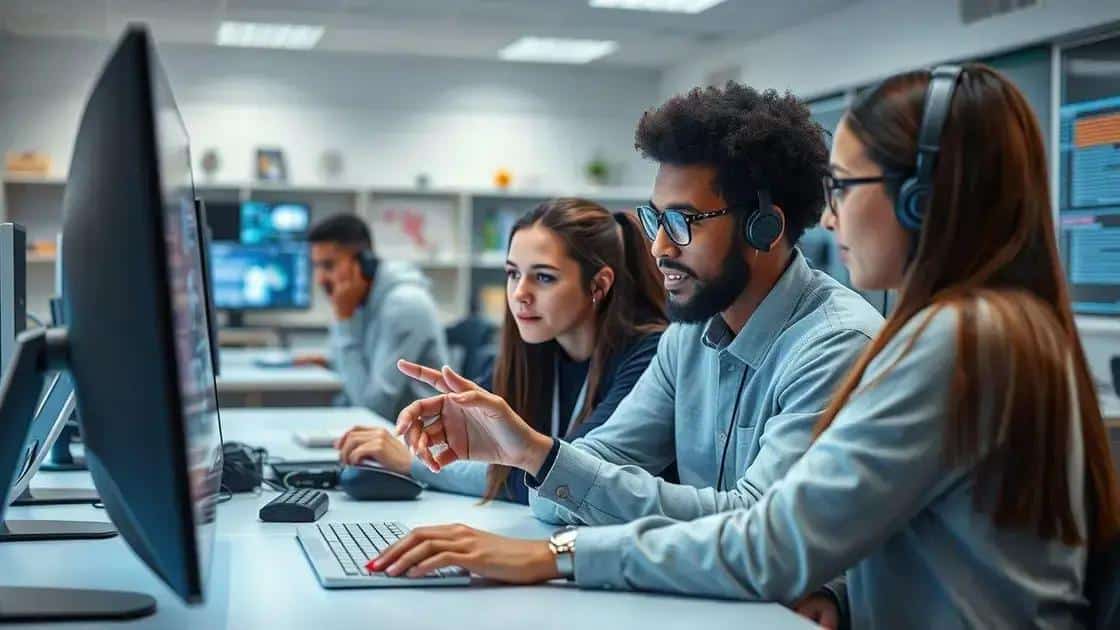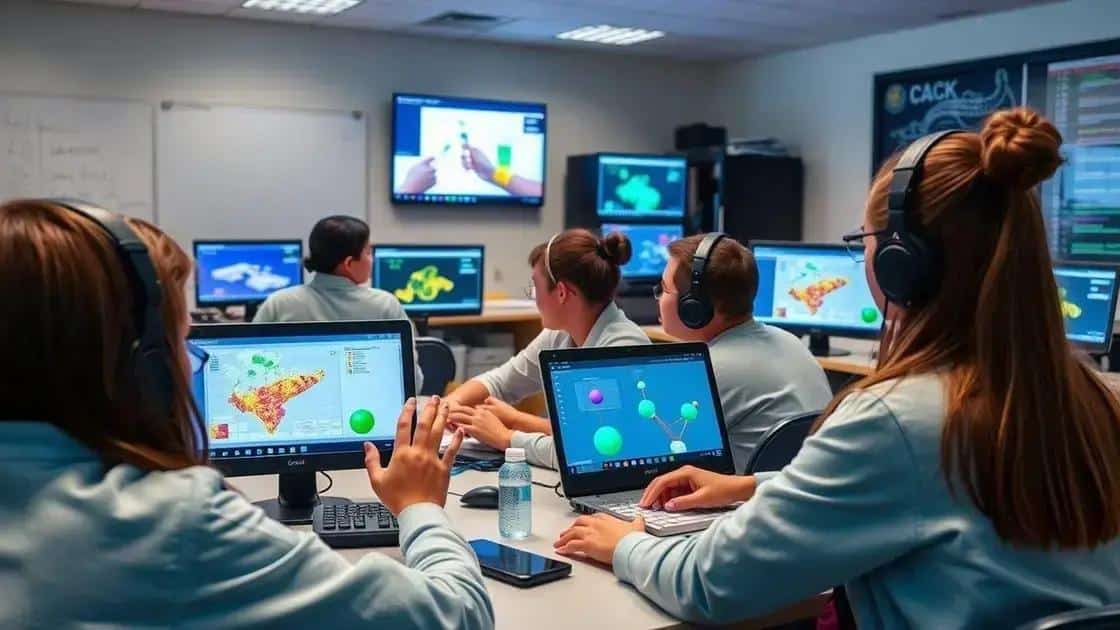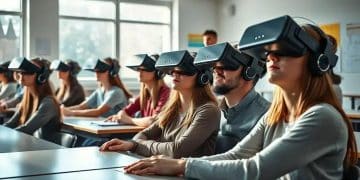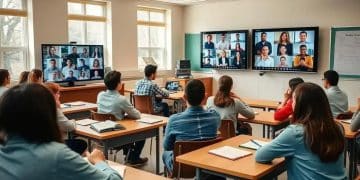Insights on virtual lab simulations: a game changer

Virtual lab simulations provide interactive, hands-on learning experiences that enhance student engagement, promote collaboration, and lead to improved educational outcomes in various subjects.
Insights on virtual lab simulations reveal a transformative approach to learning, allowing students to experiment in a safe and versatile environment. Ever thought about how these tools could change your study routine?
what are virtual lab simulations?
Virtual lab simulations are innovative educational tools that allow students to experiment and learn in a controlled, virtual environment. These simulations replicate real-world scenarios, giving learners the opportunity to conduct experiments without the risk or limitations of physical labs.
In essence, they combine technology with pedagogy to create immersive learning experiences. By using these simulations, students can grasp complex concepts more effectively.
Key Features of Virtual Lab Simulations
These simulations offer several exciting features that enhance the learning experience:
- Interactivity: Students engage directly with the simulation, manipulating variables and observing outcomes.
- Accessibility: They can be accessed from anywhere, providing flexibility for learners.
- Risk-free experimentation: Students can explore and make mistakes without real-world consequences.
- Immediate feedback: Instant results allow learners to adjust their approach and deepen their understanding.
The integration of virtual lab simulations into curricula helps foster a deeper understanding. Students can visualize processes that would otherwise be challenging to grasp. For example, a chemistry student can simulate a chemical reaction, observing the changes without being in a laboratory setting.
Moreover, these simulations can cater to diverse learning styles. Visual learners, for instance, benefit immensely from seeing phenomena in action. Meanwhile, auditory learners can appreciate tutorials and guided explanations embedded within the simulation. The adaptability of virtual labs means that they can be tailored to enhance learning outcomes.
Ultimately, the growing popularity of virtual lab simulations signifies a shift in educational methods. They are not just a substitute for traditional labs; instead, they provide unique opportunities for exploration and discovery. As technology advances, the potential for these simulations in education will continue to expand, making learning more engaging and effective.
benefits of using virtual lab simulations

The benefits of using virtual lab simulations are numerous, providing students with unique opportunities to learn effectively. These simulations enhance the learning experience by breaking the barriers of traditional lab settings.
One major advantage is the flexibility they offer. Students can engage with lab simulations anytime and anywhere. This accessibility means learners can explore concepts at their own pace, allowing for personalized learning experiences.
Enhanced Engagement
Another significant benefit is how these simulations boost student engagement. With realistic, interactive scenarios, learners become active participants in their education. Unlike standard textbooks, virtual labs allow students to see results as they experiment.
- Increased motivation: Engaging visuals and interactivity motivate students to dive deeper into subjects.
- Hands-on experience: Virtual labs replicate real-world problems, offering practical, hands-on opportunities in a safe space.
- Improved retention: Interactive learning enhances memory retention, making it easier for students to recall information later.
Moreover, virtual lab simulations foster collaboration among peers. Students can work together in virtual environments, discussing ideas and sharing strategies. This collaborative aspect helps develop essential teamwork skills that are vital in today’s workforce.
Additionally, these tools often come equipped with powerful analytics. Educators benefit from insights into student performance. They can identify strengths and weaknesses, tailoring instruction to meet the needs of each learner. This data-driven approach maximizes educational outcomes while fostering a supportive learning atmosphere.
Ultimately, the advantages of virtual lab simulations transform how students and educators approach learning. With robust engagement, flexibility, and valuable feedback, these simulations play an essential role in modern education, paving the way for inspired, effective learning experiences.
how to effectively implement virtual lab simulations
Implementing virtual lab simulations effectively can enhance the educational experience for students. It starts with understanding the objectives of the course and how these simulations can align with those goals.
First, instructors need to choose the right platform. There are various tools available, each with distinct features and capabilities. Selecting one that matches the subject matter and learning outcomes is crucial for success.
Steps for Implementation
The following steps can guide educators through the process:
- Define learning goals: Clearly outline what students should achieve through the simulations.
- Train educators: Provide training for teachers to become proficient with the simulation tools, ensuring they can effectively guide students.
- Integrate into the curriculum: Seamlessly weave simulations into lesson plans, making them a natural part of the learning journey.
- Gather feedback: Regularly solicit feedback from students about their experiences to improve future simulations.
In addition to these steps, creating engaging content within the virtual labs can significantly enhance learning. Use animations and interactive elements to make the experience captivating. Active participation encourages learners to think critically about the subject matter.
Moreover, collaboration is vital. Encourage students to work together during simulations. This not only develops teamwork skills but also enriches the learning process as they share ideas and strategies. Group projects can be particularly effective in virtual environments.
Another important aspect is ongoing assessment. Utilize analytics provided by the simulation platforms to track student progress. This data can help educators adjust their teaching methods and provide additional support where needed. Regular check-ins can also motivate students to stay engaged.
Lastly, be flexible and adapt. Based on the gathered data and student feedback, continuously refine the simulations. Adapting to the needs of the learners ensures that the educational experience remains relevant and effective.
case studies: success stories with virtual labs

Case studies provide valuable insights into the success stories with virtual labs. These real-world examples showcase how educational institutions have effectively integrated virtual lab simulations into their curricula, leading to improved learning outcomes.
For instance, a high school in California decided to implement virtual science labs to enhance their chemistry curriculum. By using virtual lab simulations, students were able to conduct experiments that would be challenging or dangerous in a physical lab. The results were impressive: students reported a deeper understanding of chemical reactions and improved grades.
Notable Examples of Success
Several schools and universities have shared their success with virtual labs:
- Community College Success: A community college in Texas increased student enrollment in science courses by 30% after introducing virtual labs, as students found the interactive nature more appealing.
- STEM Initiative: An initiative in a New York school district combined virtual labs with hands-on activities, resulting in a 40% increase in students’ performance in STEM subjects.
- Remote Learning: During the pandemic, universities adopted virtual labs, which allowed students to continue hands-on learning safely. This transition resulted in high satisfaction rates among students.
These stories illustrate how the adoption of virtual lab simulations can transform educational experiences. They provide flexibility and safety while maintaining hands-on learning, which is essential in subjects like science and engineering.
Furthermore, educators noted that using virtual labs encouraged more collaboration among students. Group projects in virtual settings enabled students to communicate effectively and work together toward common goals. This collaboration has prepared them for future careers where teamwork is vital.
As more institutions share their positive outcomes, the momentum for virtual labs continues to grow. The ease of accessing virtual simulations allows educators to reach diverse student populations. This inclusivity helps bridge gaps in learning opportunities.
FAQ – Frequently Asked Questions about Virtual Lab Simulations
What are virtual lab simulations?
Virtual lab simulations are interactive tools that allow students to conduct experiments and learn in a safe, online environment.
How do virtual lab simulations enhance learning?
They provide hands-on experiences, increase engagement, and promote collaboration among students.
What are some success stories related to virtual labs?
Many schools report improved grades and increased interest in STEM subjects after implementing virtual labs.
How can I effectively implement virtual lab simulations in my classroom?
Choose the right platform, train educators, and integrate simulations into your curriculum while gathering feedback for improvement.





